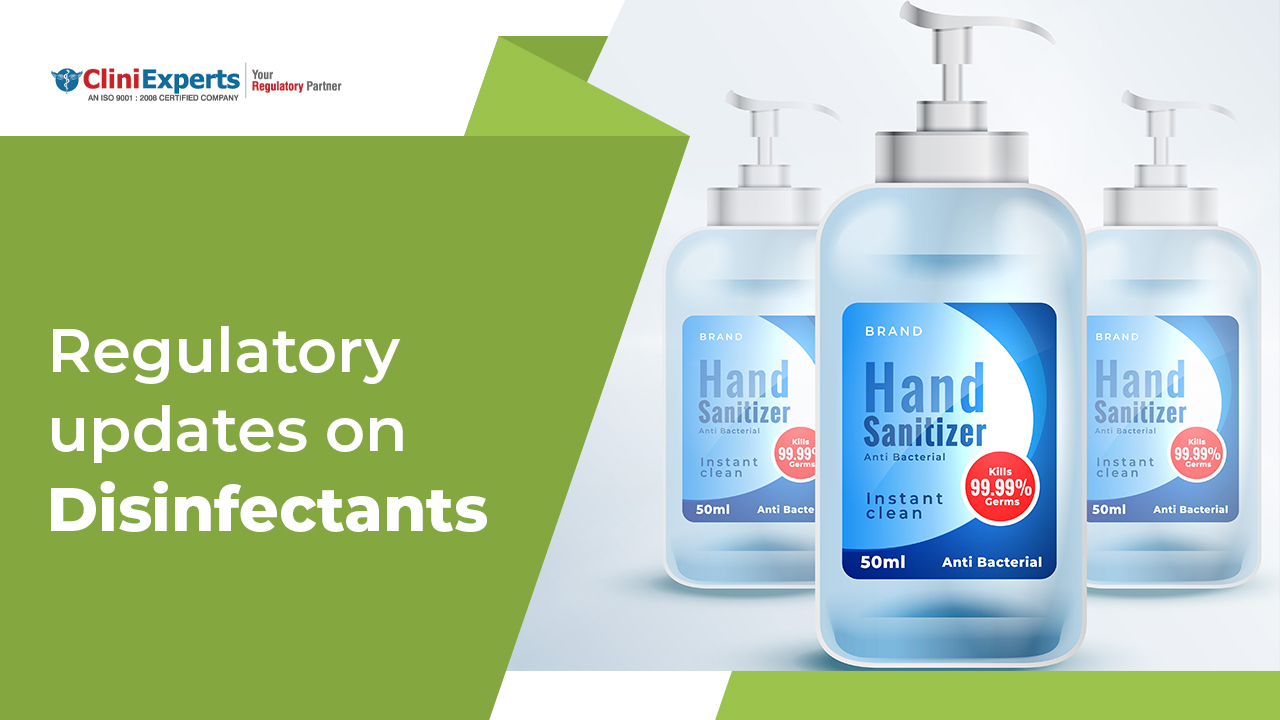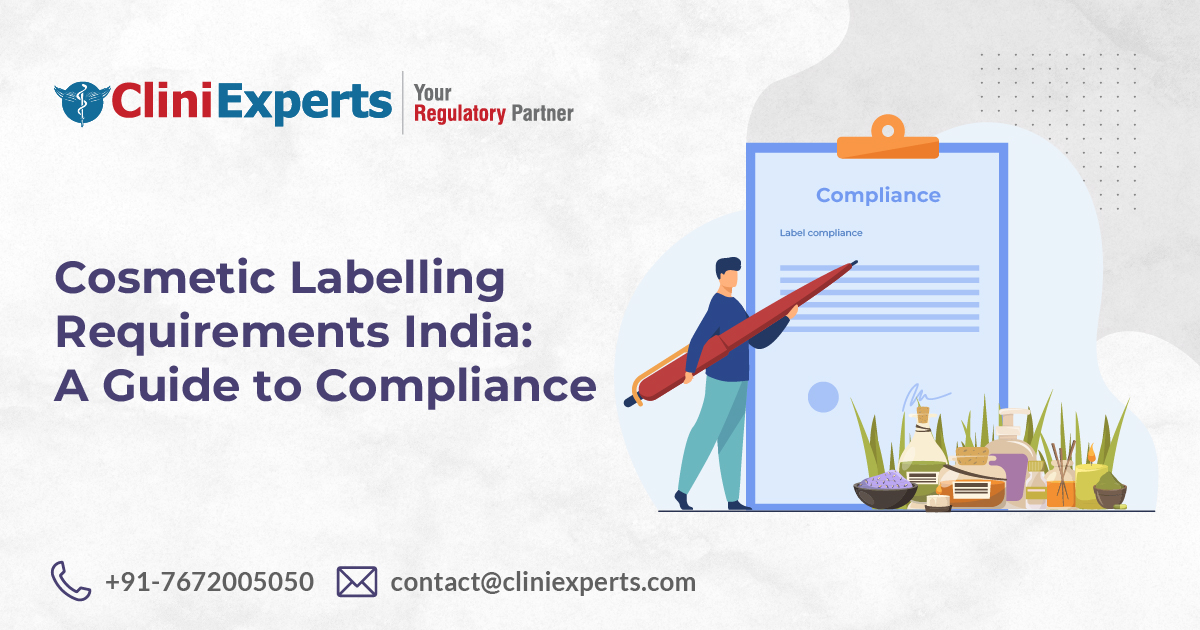Regulatory Updates on Disinfectants

Sanitizers can be of different variants, primarily based on active ingredients, such as soap containing natural fats, detergents, or alcohol-based (Table 1). The Centers for Disease Control and Prevention (CDC) recommends the use of Alcohol Based Hand Sanitizers (ABHS) as a first-line preventive measure against Covid-19.
| Type | Product Formulation | Product Form | Concentration | Contact Time | Log 10 Reduction |
| Alcoholic Formulations | Alcohol | Solution | 60.5-95%(w/w) | 10-15s | >=3.25-4.01 |
| Non-Alcoholic Formulations | Cleanser | Liquid Surfactant (10-19%w/w) | 50% | 10-20s | >=3.01-3.42 |
| Herbal or Semi –Herbal Formulation | Ayurvedic Formulation | Gel | n.a | – | – |
Alcohol-based hand sanitizers (gel) and hand rubs (liquid) together referred to as “ABHR’s” are simple formulations used to disinfect mainly the hands and get rid of bacteria, viruses, fungi etc. to prevent further transmission. A good sanitizer should destroy 99.99% microbes in ~20-30 seconds4,5 should be safe on skin over long-term use and optionally have a light non-overpowering fragrance.
With the advent of the COVID-19 pandemic, hand hygiene has gained prominence and also advised as one of the ways to control its spread. Thus the requirement and demand for ABHR’s has suddenly increased, mandating the WHO to issue recommendations to improve hand hygiene practices6,7and formulae for its local production.8 The CDSCO has released a list that gives examples of composition of hand sanitizers/surgical hand disinfectants that includes those recommended by WHO for local production to meet neighborhood demand. 9 The DGCI has directed State Drug controllers to expedite issue of manufacturing licenses by notifying ABHR’s under the Essential Commodities Act, 1955 to regulate their production, quality, distribution and logistics along-with masks (2ply and 3ply surgical masks, N95 masks).
The proper classification of ABHR’s and consequent regulation under appropriate provision has become a contentious issue, resulting in lack of initial clarity for producers, distributors, and retailers. Initially the Central Government had notified disinfectants as a drug, under S.3 (b)(ii) of the Drugs and Cosmetics Act, 194011 [vide Notification No. 1-20/60D, dated 03.06.1961] by the definition of a drug as “such substances (other than food) intended to affect the structure or any function of the human body or intended to be used for the destruction of vermin or insects that cause disease in human beings or animals”
Later this was broadened to exempt and permit ABHR’s to be stocked and sold without a drug licence like Oral Rehydration Salts, medicated dressings and similar class of products. Exempted items are listed in Schedule K (12) of the Drugs & Cosmetics Rules, 194512and includes “Substances intended to be used for destruction of vermin or insects which cause disease in human beings or animals, viz. insecticides and disinfectants” and disinfectants were considered as all the chemical agents that would destroy or inhibit the growth of pathogenicmicro-organisms to include antiseptic lotions and sanitizers.
This is substantiated by the US Pharmacopeia(USP)13 and the ‘Harmonized System Nomenclature’, developed by the World Customs Organization, in its Chapter Heading 3808 both of which group sanitizers as disinfectants(HS code).14
Ayurvedic and Cosmetic ABHR’s: The antimicrobial and antipathogeniceffect of herbal formulations have been studied.15,16Production and sale of such items do not require drug stock and sale license as an ayurvedic drug is made under an ayurvedic drug manufacturing license and a cosmetic under the cosmetic manufacturing license.17However, no ‘drug’ claim can be made on the label of a cosmetic as it will attract strict regulatory action under DCA. The definition of ‘drug’ under DCA is broad and covers all substances that are intended to be used in the prevention of disease in human beings.
Ayurvedic ABHR’s18are restricted by the limit on alcohol content i.e. alcohol used in the manufacture of antiseptic solutions should not contain alcohol in excess than is necessary for the preservation of (ayurvedic) ingredients. As ABHRs typically have 60%+ alcohol content, manufacturers and marketers of ABHRs must ensure that their product passes the above test.
Manufacturers selling formulation of ethyl alcohol 70% (v/v) have to obtain a prior price approval from National Pharmaceutical Pricing Authority (NPPA)19, before manufacturing ABHR containing ethyl alcohol as per the procedure prescribed under DPCO.
The Drug (Prices Control) Order, 2013 (“DPCO”)20 regulates the prices and distribution of ABHRs containing ethyl alcohol 70% (v/v) since 2013 and presently capped at Rs.112 per 200 ml but not applicable to ayurvedic or cosmetic hand sanitizers. The previous limit of Rs.100/200 ml as per the “Hand Sanitizer Price Control Order” was only till June 2020.21
Caution against spurious products: Indian State drug control departments have also reported that some small players have also resorted to sourcing low quality ingredients for manufacturing sanitizers with harmful impurities like benzene and toluene among others which can damage skin and do more harm than relief. Popular e-commerce platforms have over 10,000 sanitizer brands and definitely over 500 of them claiming to be of ayurvedic properties.22
As per the ‘Medical Product Quality Report – COVID-19 Issues’ of the 140 articles related to substandard and falsified (SF) equipment used in the protection against SARS-COV-2, 68 articles were about SF hand sanitizers and products to disinfect surfaces. This report lists spurious/inferior/low quality/below standard products that were produced and sold in various countries including in the ‘developed world’, taking undue advantage of the high demand for such products.23
False claims and mislabeling: Hand sanitizers are not allowed to make false claims of preventing COVID-19, use of ‘WHO recommended’ or use of any Government logo to imply its effectiveness. Even if a manufacturer is able to manufacture the exact formulation as recommended by WHO, they should not claim on the label or packing that it is manufactured “as per WHO recommended formula”.
A proper label must mention that it contains denatured alcohol (in case of use of methylated spirit) and that it is for external use only as well as its storage conditions and average percentage of absolute alcohol. A manufacturer cannot sell different formulations of ABHRs under a common brand name e.g. if one is under the pharma drug license and the other under an ayurvedic drug license. Also, the drug’s quality will be the liability of both the manufacturer and the marketer from 1st March 2021.24
So whether you are a producer, stockiest, retailer of hand sanitizers (ABHR’s) and similar products – be aware of these fine differences and comply with the applicable regulations based on the product composition. Consumers also need to be aware of this to purchase and responsibly use the correct product both for its effectiveness and avoid undesirable side effects.
References
- https://doi.org/10.1016/j.scitotenv.2020.140561
- https://doi.org/10.1017/S0950268820002319
- https://doi.org/10.21203/rs.3.rs-526772/v1
- https://www.cdc.gov/infectioncontrol/guidelines/disinfection/glossary.html#S
- https://www.ircc.iitb.ac.in/IRCC-Webpage/rnd/Prof_RintiBanerjee.pdf
- https://www.who.int/docs/default-source/inaugural-who-partners-forum/who-interim recommendation-on-obligatory-hand-hygiene-against-transmission-of-covid-19.pdf
- https://www.who.int/gpsc/5may/Hand_Hygiene_Why_How_and_When_Brochure.pdf
- https://www.who.int/gpsc/5may/Guide_to_Local_Production.pdf?ua=1
- https://cdsco.gov.in/opencms/opencms/system/modules/CDSCO.WEB/elements/download_file_division.jsp?num_id=NTc4Mg==
- http://www.pharmabiz.com/NewsDetails.aspx?aid=121853&sid=1
- https://cdsco.gov.in/opencms/export/sites/CDSCO_WEB/Pdfdocuments/acts_rules/2016
- http://www.mogsonline.org/pdfs/shedule_k.pdf
- https://www.usp.org/news/usp-expands-alcohol-based-hand-sanitizer-support
- https://wits.worldbank.org/trade/comtrade/en/country/ALL/year/2018/tradeflow/Exports/partner/WLD/nomen/h5/product/380894
- http://dx.doi.org/10.26452/ijrps.v11iSPL1.2718
- https://sphinxsai.com/2013/janmar/pharmpdf/PT=06(40-43)JM13.pdf
- https://drugs.kar.nic.in/node/233.html
- https://www.ayush.gov.in/docs/124.pdf
- http://pharmaceuticals.gov.in/dpco2013gaz.pdf
- https://consumeraffairs.nic.in/sites/default/files/fileuploads/latestnews/Notification21ar2020.pdf
- http://www.pharmabiz.com/NewsDetails.aspx?aid=128978&sid=1
- https://www.tropmedres.ac/files/mpqr-reports/medical-product-quality-report_covid-19-issues_issue-1-jan-june-2020_main-text_10aug2020.pdf
- https://cdscoonline.gov.in/CDSCO/homepage
- https://www.lexology.com/library/detail.aspx?g=b44ab4bf-f596-4747-84bcec93c28b9ee7
Recent Posts
Organic Food Labelling In India| Certification, and Import of Organic Food in India

This Article is All About Organic Food Labelling In India and Certification, and Import of Organic Food in India. Explained in Detail About What is Organic Food labelling? Summary Short Description Wi..
Cosmetic Label Compliance India : A Guide to Compliance

Introduction Looking for Cosmetic Label Compliance India? Are you a cosmetic manufacturer or importer navigating the complex world of Indian regulations? Ensuring your product labels comply with the l..
Clinical Investigation Approvals: An Overview of Forms MD-22 and MD-23

Summary Short Description Strict regulatory protocols govern clinical investigations for medical devices. Central to this process are forms MD-22 and MD-23. Form MD-22 is an application to Central Lic..
HAVE A QUERY?
REACH US!Office
New Delhi
Unit No. 324 & 325, City Centre Mall, Plot No. 5, Sector 12, Dwarka, India - 110075
+917672005050
Bengaluru
RMZ Galleria, 1st floor, Ambedkar Colony, Yelahanka, Bengaluru, Karnataka, India – 560064
Call us on
Sales: +91 7672005050
Reception: +91-11-45214546
Timings
9 am to 6 pm (Monday to Friday)


